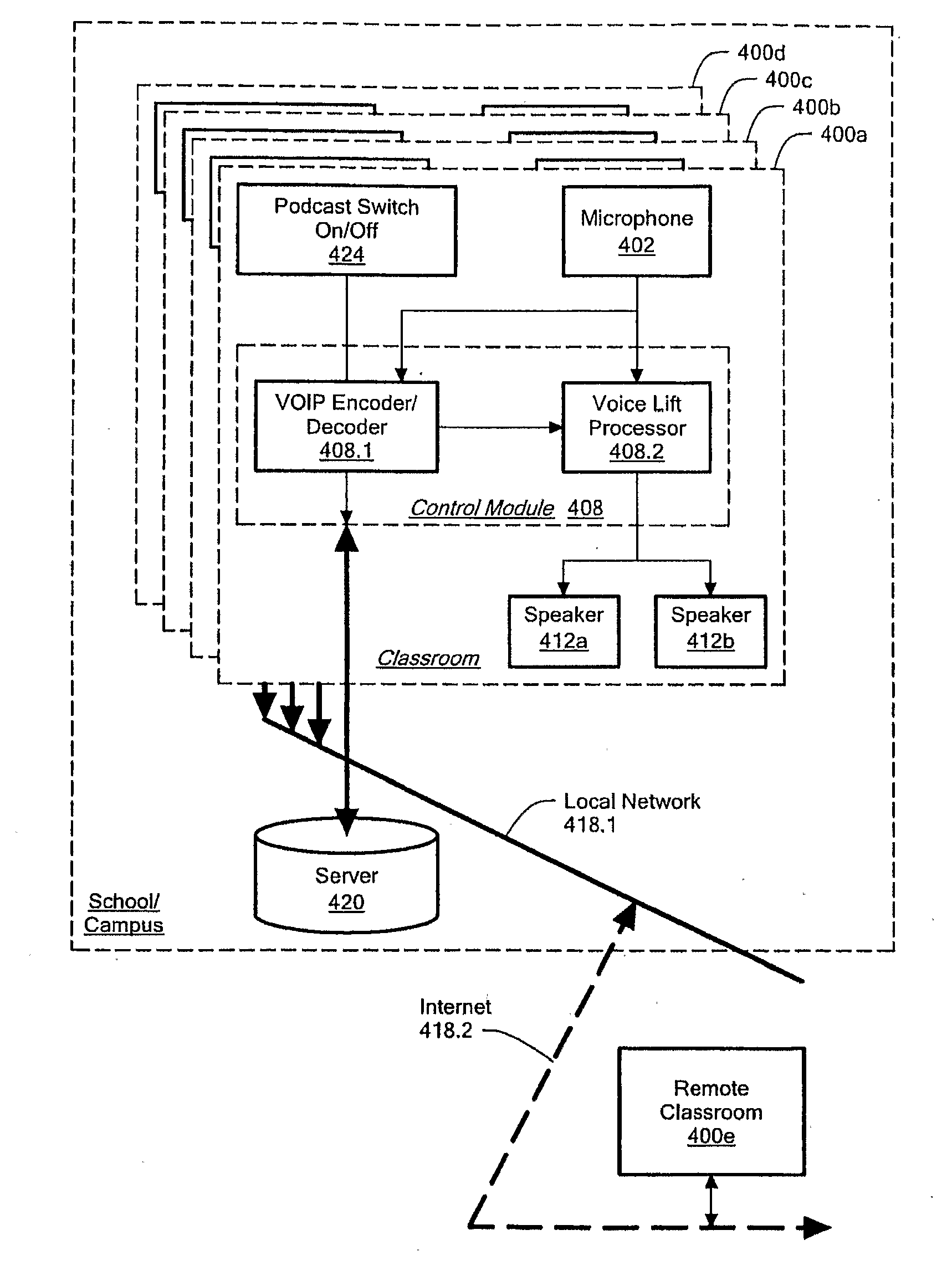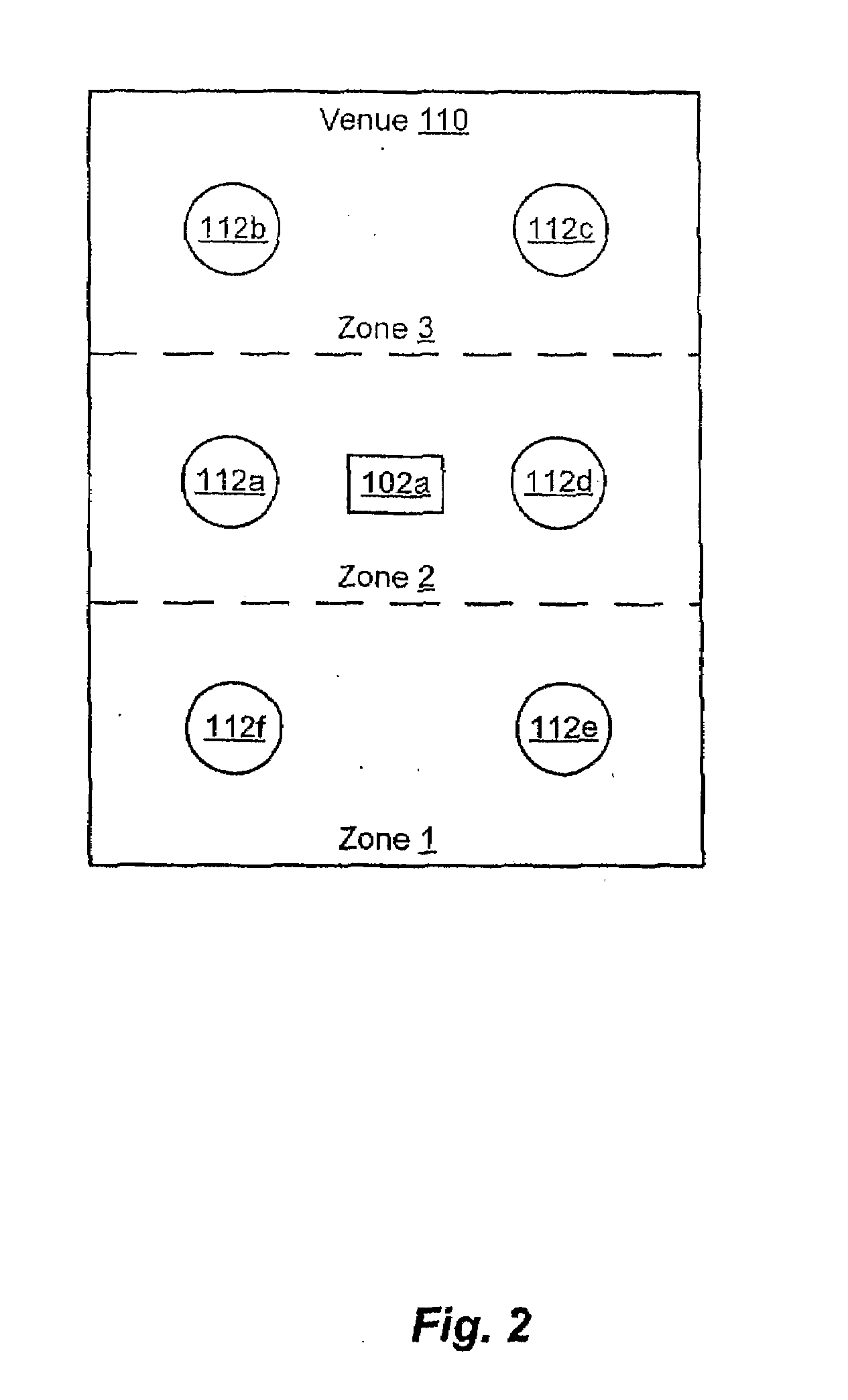[0006]In accordance with the present invention, an improved system and method is disclosed for providing sound reinforcement in a classroom, an office, a
conference room, an auditorium, or any other suitable venue. The presently disclosed system and method can be configured to provide a voice reinforcement (“voice lift”) function via a plurality of spatially distributed emitters (“loudspeakers”), thereby providing a more uniform
sound field coverage and allowing a talker'
s voice to sound equally natural and equally intelligible at all listener locations within the venue of interest. The disclosed system and method can also be configured to provide a sound masking function, preferably via the same plurality of spatially distributed loudspeakers used for the voice lift function. In this way, more uniform levels of acoustic sound masking signals can be generated throughout the venue in which the system is deployed.
[0007]In one embodiment, the presently disclosed
sound reinforcement system includes a plurality of microphones, a receiver, a sound masking
signal generator, a
system controller, and a plurality of spatially distributed emitters (“loudspeakers”). Each of the microphones is operative to detect the speech of a talker, and to generate at least one voice signal corresponding to the detected speech. The voice signal generated by each microphone may be a
wireless (e.g.,
infrared (IR) or
radio frequency (RF)) voice signal, and the receiver may be a
wireless (e.g., IR or RF) receiver operative to receive the
wireless voice signals from the microphones. For example, when the disclosed
sound reinforcement system is deployed in a classroom environment, one of the microphones may be worn by an instructor either on a lanyard, clipped as a lavaliere, or as a
headset, while one or more of the other microphones may be of a hand-held type suitable for being passed from one student to another during periods of student participation. Further, the wireless receiver may be configured to be mountable to the ceiling to assure that the IR or RF signals generated by the microphones worn by the instructor and held by the students are received with minimal obstruction and / or interference. The sound masking signal generator is configured to store at least one set of information specifying at least one sound masking spectrum, and to generate at least one electrical sound masking signal having the sound masking spectrum specified by the stored set of information. The
system controller is operative to receive the voice signals and the sound masking signal from the microphones and the sound masking signal generator, respectively, to provide the voice signals on at least one first channel, and to provide the sound masking
signal on at least one second channel. Like the wireless receiver, the plurality of spatially distributed loudspeakers is configured to be mountable at the ceiling level. Each of the loudspeakers has a low
directivity index, and is arranged to face downwardly from the ceiling. In addition, each of the loudspeakers can be configured to receive both the voice signals and the sound masking signal provided on the first channel and the second channel, respectively, and to emit acoustic voice and sound masking signals corresponding to the received voice and sound masking signals, respectively, simultaneously and directly into the venue in which the system is deployed. As a result, a more uniform
sound field coverage for the acoustic voice signals, and more uniform levels of the acoustic sound masking signals, can be obtained throughout the venue of interest.
[0009]The presently disclosed
sound reinforcement system provides features that address the communication needs of individuals who gather to meet in small or large venues such as classrooms, offices, conference rooms, auditoriums, etc. For example, the plurality of spatially distributed loudspeakers has
low voltage and power requirements and can be easily installed at the ceiling of the venue to provide distributed audio delivery and a more uniform sound field coverage, thereby allowing a reduced overall sound level for a given Articulation Index. Further, to mitigate
delay-related phenomena caused by the Haas effect (also called the “precedence effect”) when the system is deployed in larger venues, the receiver can be configured to perform microphone localization
processing, including calculating
time delays to be applied to the voice signals generated by the talker's microphone based upon the relative distances between the microphone and the spatially distributed loudspeakers. As a result, the talker'
s voice can be made to have a more natural sound at all listener locations in the venue no matter where the talker is currently located.
[0010]Moreover, when the disclosed sound reinforcement system is deployed in a classroom environment, the system can employ the sound masking function to reduce the actual or perceived level of student activity
noise and / or background or ambient
noise emanating from inside and / or outside of the classroom, thereby allowing the students concentrate on the teacher, to study, to take tests, and to perform group work with significantly less
distraction. In addition, the receiver can be configured to receive voice input signals from the instructor and one or more of the students simultaneously, and the system controller can be configured to provide the voice signals of the instructor and students on respective channels for subsequent transmission as acoustic signals via the spatially distributed loudspeakers. The receiver can also be configured to incorporate one or more internal antennas, and / or to interface with one or more external antennas, to obtain spatial diversity or any other desired RF diversity reception for reducing the occurrence of drop-outs as the instructor speaks into the microphone while moving about the classroom. Rechargeable battery packs and / or docking stations may also be provided for the instructor and student microphones.
 Login to View More
Login to View More  Login to View More
Login to View More 


